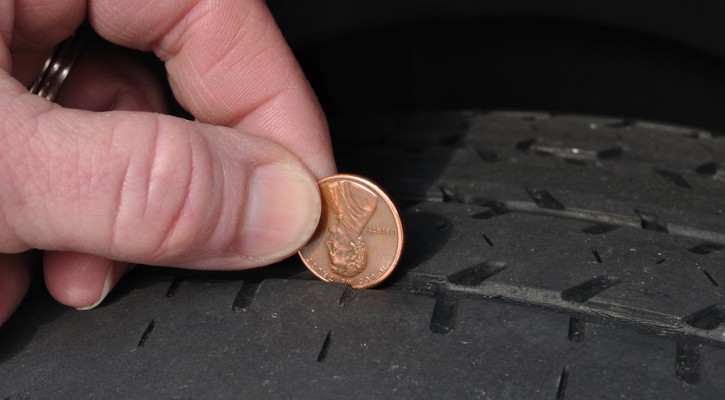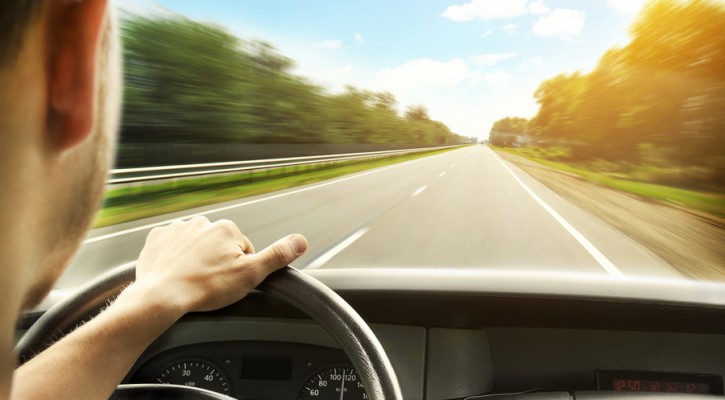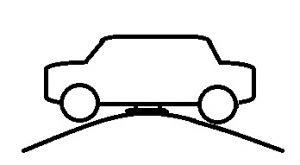Tag Archive: safe driving

Train Crash Escape Route
November 16, 2016
If you’re facing a train crash, what’s the best escape route for you? A trucker in Georgia faced this problem yesterday when he found his truck stuck on the railroad crossing. The trucker probably didn’t consider the height of the railroad grade when he tried to drive over it and, as he crossed to the other side, found the bottom of his trailer had failed to clear and he was stuck fast on the rails.
If you find yourself stuck or stalled on the rails at a railroad crossing, the experts say you should get out of the vehicle and escape in the direction of the oncoming train. However, a lot of people have a hard time understanding that rule. If you’re facing a train crash, why run toward the train?
The picture below shows why your escape route needs to be away from the tracks in the direction of the train. Once the train hits your vehicle, debris is going to be spread out in in the direction in which the train is traveling. If your escape route is away from the train, chances are that you’re going to be hit by all that exploding debris scattered outward from the crash. It’s not a position you want to be in.
Click on picture to enlarge
You can avoid being stuck on the tracks to begin with by;
- Never stopping on the railroad tracks. If there’s traffic ahead, wait until the traffic clears and there’s enough clear room for you on the other side of the tracks before you cross.
- Never trying to beat a train at a crossing; the train will always win.
- Knowing the bottom clearance of your vehicle. If you think the railroad grade may be too high, stop and find another route.

Prom Night: One Item Parents Should Splurge On
April 7, 2015
Prom night is just around the corner an proms can get pretty expensive for parents; from expensive dresses, tux rentals, flowers, and photos, it can all add up. However, there’s one item parents should really consider splurging on to keep their kids safe on prom night; a limo.
Prom night can be one of the most dangerous nights of the year. In spite of all the warnings that parents give, once the kids are out of sight, there’s really no way to predict what they may do or prevent them from participating in some of the more dangerous activities on prom night such as drinking or using drugs. At that age, peer pressure can be much more powerful than parental rules and warnings.
Prom night isn’t a night when you want to trust the driving to a teen. A recent study showed that sixty percent of teen crashes are caused by driver distraction. It’s not just texting and cell phones that cause the distractions. In fact, the biggest distraction for teen drivers is interacting with their teen passengers. Even if the kids remain sober, the excitement, novelty and the gathering of friends can be very distracting to a young driver. Driving late at night, after a long day of planning and the activities at the prom itself, can lead to drowsy driving. Also, even if the kids are sober, there are more drunks on the road on those late weekend nights and those drunk drivers combined with distracted teen drivers can lead to tragedy.
Parents should consider hiring or at least contributing to the hiring of a limo. If the parents do the hiring, then the limo driver works for them and the parent can set down certain rules for where the kids can go and at what time they should return. To save embarrassing the teen, the parents can arrange to check in with the limo driver for updates. The teens can feel glamorous and be as loud, raucous and distracting as they want while riding safely in the back, while the limo driver, sealed off in the front, concentrates on the road ahead. It’s a win-win situation for all.

Planning For A Fun And Safe Spring Break
March 3, 2015
It’s that time of year again and the warm beaches of Florida are going to be prime destinations for spring breakers. Spring break is a lot of fun and can provide a lifetime of memories but it can also, just as easily, turn tragic. If you’re headed to the coast, remember the lessons learned in your drug and alcohol course as well as our top safety tips for a safe spring break.
- Maintain a buddy system – Travel with friends and stay with those friends to keep each other out of trouble. Along with college students, spring break also attracts unsavory types such as thieves and sexual predators. Don’t go off alone with someone you don’t know.
There are a lot of reasons not to drink but, if you feel you must:
- Have a plan – Plan on how you’ll get home safely, either by cab or a designated driver. Plan to limit your drinking. If you make a plan before you go out, chances are, you’ll stick with that plan but if you wait until after you’ve been drinking to decide what to do, your judgment will be clouded and you could drink yourself into trouble.
- Limit your drinking – While the effect of alcohol is different on everyone, a general rule of thumb is that it requires at least one hour for the body to process the alcohol from one drink. The more you drink, the longer it takes for the body to process the alcohol and get it out of your system. For females, who are generally smaller, one drink can affect you much more quickly than it will for a male and can take longer for the body to process.
- Binge drinking is deadly – Your body can only process so much alcohol before it becomes toxic. Alcohol affects your motor skills. You quickly start to feel the effect on the voluntary motor skills that control your speech, vision and ability to walk but too much alcohol can shut down the involuntary muscles controlling the heart and lungs and death from alcohol poisoning is the result. Drinking games look like fun but, for your own safety, make a plan before you go out not engage in any games that could lead to alcohol poisoning.
- Know what you’re drinking – Different drinks have different amounts of alcohol. Some sweet, flavorful cocktails can have up to four shots of liquor. Depending on your body size, a single cocktail can immediately put you over the legal limit.
- Females; guard your drinks – A female who leaves her drink unattended can easily become the victim of a sexual predator who has slipped Rohypnol (the date rape drug) into her drink. If you leave your drink unguarded at any time, dump it and get a fresh drink.
- Alcohol and the sun don’t mix – If you only drink alcoholic drinks when you’re out in the sun, you can easily become dehydrated. The combination of the sun and activities can quickly wear you out and alcohol will compound that effect. Switch off with water or fruit drinks.
- If it seems like a crazy stunt, it’s probably too dangerous – After drinking, spring breakers have died trying to show off by balancing on bannisters, doing pull ups off of hotel balconies, or trying to dive from a balcony into the hotel pool. Unfortunately, instead of stopping them, their friends, also under the influence of alcohol, urged them on. If you see someone trying to pull a dangerous stunt, try to stop them or call local security. You could save their life.
- Scooters and mopeds – If you rent a scooter or moped, make sure you’re familiar with its operation and watch out for other drivers on the road who may not be watching out for you. Never try to operate a scooter or moped if you’ve been drinking.
- Don’t party to the end – Don’t try to party up to the last second before leaving for home. If you’re driving, everyone in your party should try to get a good night’s sleep before heading home. Driving drowsy is just as dangerous as drunk driving.
- Stay alert driving on the road – Share driving duties and switch off with other drivers to remain alert. Long periods on a boring interstate can lead to “highway hypnosis”; avoid that by stopping every two hours or 100 miles to refresh yourself or take a short nap. If you have a long way to drive, don’t try to do it in a single trip. Stop and get some rest before continuing.
- DON’T DRIVE DRUNK OR DRUGGED!!!! – It should go without saying but there are far too many tragedies on spring break because people ignored this simple piece of advice!

Teens Don’t Know How to Check The Tires
August 27, 2014
Almost half of teen drivers in the US don’t know how to check their tires for wear or proper pressure. Results from a study conducted by Michelin North America showed that teens aren’t getting basic vehicle maintenance training in state driver training courses or from their parents. Basic maintenance checks on tires, windshield wipers, fluid levels, and lights are an important part of driving safety yet the study shows that:
- 27% of teens never check the condition of their tires.
- 44% of teens don’t know how to check the tire tread for wear.
- 29% don’t know how to check the oil.
- 57% don’t know how to change the windshield wipers. Continue Reading

Ask The Driving School Instructor: Driving With One Hand
August 25, 2014
Question: Is it safe to drive with one hand?
Answer: I will say that it’s only safe to drive temporarily with one hand but not all the time. If you need to adjust a control such as the air conditioner or windshield wipers or to pick up something one hand on the wheel is fine. However, you shouldn’t get in the habit of driving with one hand all the time. Driving with one hand doesn’t give you full control over steering and it could hurt you very badly in certain circumstances. Let’s look at a couple of the ways that driving with one hand could be dangerous.
Driving distractions can be even more dangerous when driving with one hand. Most people tend to put their hand at the top of the steering wheel. If you were to to turn your body to look for or to reach for something, you may inadvertently pull the wheel in the direction your body is turning. If that happens while your eyes are off the road, you could drive over into the other lane or off the side of the road.
If you were suddenly involved in a traffic crash in which your airbag deployed, with one hand positioned at the top of the wheel, your hand and arm are going to be driven back into your face at 200 mph. It could break your arm and it isn’t going to do wonders for your face either.
Older drivers were taught to always keep their hands at the 9 or 10 o’clock and 3 or 2 o’clock positions on the steering wheel. Today, because of airbags, safety experts suggest keeping your hands lower on the wheel at the 8 and 4 o’clock positions. Don’t wrap your thumbs around the wheel. Instead, rest your thumbs on top of the wheel. With your hands and thumbs in this position, you’ll have more control and you’re less likely to be injured if your airbag deploys.


